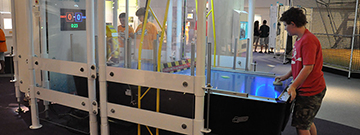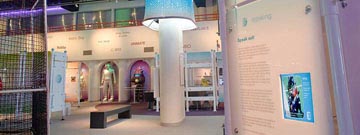Terrain Navigation
Exploring the surface of Mars, investigating volcanic craters, checking ice conditions in the Antarctic – they all sound like dangerous jobs suited best for machines, not humans. But navigating the rough ground of these environments requires highly sophisticated robotics technologies.
Engineers are challenged with determining how robots travel across a wide variety of terrain, whether by complex legs or wheels. Visitors have the opportunity to explore various types of wheel configurations to determine how a robot, simulated by a simple wind-up car, will travel across varied terrain. In addition to configuring the wheels of the car, visitors will explore through video how robots have taken on the shapes of snakes, lizards, insects, fish, and even dogs in order to serve a required function. Each of our ‘robot rovers’ here uses different equipment to move across a specific surface. Give them a try to see where each works best!
Local Connection
Crusher, an unmanned, six-wheeled robotic vehicle, was designed to function autonomously on challenging off-road terrain. Crusher was developed by the National Robotics Engineering Center at Carnegie Mellon University.











